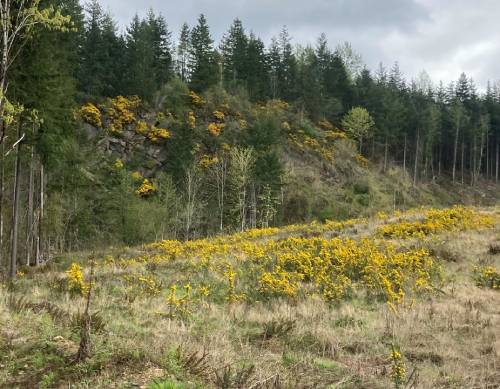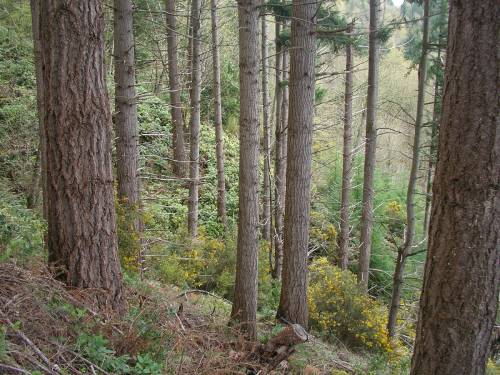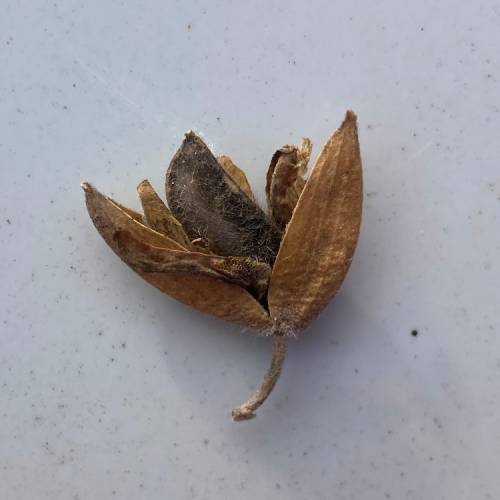Gorse identification and control
About this weed
Gorse is a regulated Class B noxious weed. Control is required in King County. Gorse is also on the Washington quarantine list making it illegal to buy, sell, or offer it for sale in the state.
Gorse is known as Ulex europaeus and it is in the Fabaceae (bean) family. It is native to the British Isles and parts of western Europe.

Why it's a noxious weed
Gorse is a spiny evergreen shrub that forms dense thickets. These thick patches can crowd out other more desirable plants. Gorse fixes nitrogen in the soil which can help other weedy plants get a foothold. Gorse seeds can last over 30 years in the soil, making re-infestation a constant problem. One mature plant can produce up to 18,000 seeds per year.
Because it forms a center of dry dead vegetation and has a high oil content, it is a serious fire hazard. In 1936 the town of Bandon, Oregon burned to the ground; 14 people died and only 16 buildings remained unburned. The disaster was fueled by hedgerows of gorse growing throughout the town.
Plant description
Gorse is a perennial (2+ year life cycle), evergreen shrub. It is dense and spiny, with yellow flowers February through April. Gorse is found in poor and sandy soils, where the nitrogen-fixing roots grow deep in search of water. In King County, gorse grows along fence rows and pastures, in vacant lots, harvested timberlands and on sandy bluffs.
Gorse can grow over 10 feet tall and 30 feet in diameter. Its branches are covered with spine-like leaves, up to 2 inches long. The flowers are yellow, form in clusters at the ends of branches, and resemble those of pea plants. Seed pods are dark brown to purple and covered with whitish hairs.






Be aware of look-alike plants
Gorse resembles these noxious weeds:
None of these look a-likes have spines like gorse.
When in doubt, take photos and share them with us or report them on iNaturalist.
What to do if you find it
Property owners are required to control gorse on lands that they manage. Please notify us if you see gorse growing in King County.
Our program staff can provide the property owner or appropriate public agency with site-specific advice on how best to remove it. We map all known locations of regulated noxious weeds such as gorse in order to help us and others locate new infestations in time to control them.
Also, because gorse is not generally established in King County, we have an opportunity to stop it from spreading if we act quickly when new plants are found.
Control methods
We recommend using a combination of methods to control noxious weeds. In areas with few weeds, it is important to act quickly before they become harder to control. Make a long-term plan as it often takes several years to get rid of most weeds. Start in the least infested areas first and then move into more heavily infested areas.
When working with gorse, be sure to wear thick gloves to avoid getting stabbed by spines. Be sure to clean your shoes and tools carefully after working in any weed infested area to prevent further spread.
For more in-depth control information, read Best Management Practices (BMP) for gorse
Manual control
Young plants, less than 3 ft tall, or seedlings can be hand pulled or dug up. This is easiest when the soil is damp. A weed wrench, which can be checked out from a King County Tool Library, can be used on larger plants.
Mechanical control
Mowing can be used as an initial brush removal step but will need to be combined with other control methods to be effective.
Cultural control
Controlled burning can be useful in controlling dense gorse infestations. Check local regulations for special permits, burn bans, or other restrictions.
Biological control
Goats may be effective in controlling seedlings or on re-growth less than 4 inches high.
Chickens eat gorse seeds, and through the digestion process the seeds are destroyed
Gorse soft shoot moth Agonopterix umbellana, has recently been approved in Washington state.
For more information about these biocontrol agents, please visit Biocontrol Factsheets - NAISMA.
Chemical control
Stay safe when using herbicide:
- Always read the label before use.
- Wear a long-sleeved shirt, long pants, shoes, and eye protection.
- Follow state and local regulations.
Gorse is best treated in late spring after flowers drop but before seed pods ripen. Selective broadleaf herbicides such as triclopyr amine or triclopyr ester, 2,4-D LV ester, metsulfuron or dicamba are the best options for gorse. Glyphosate is effective, but it will also kill any grass that it contacts.
For specific chemical recommendations, please refer to the PNW Weed Management Handbook.
Disposal instructions
For small infestations cut gorse into smaller pieces and put into heavy duty garbage bags for disposal. Composting seed pods at home or in municipal yard waste is not recommended.
Noxious Weed Disposal - Washington State Noxious Weed Control Board

 Translate
Translate